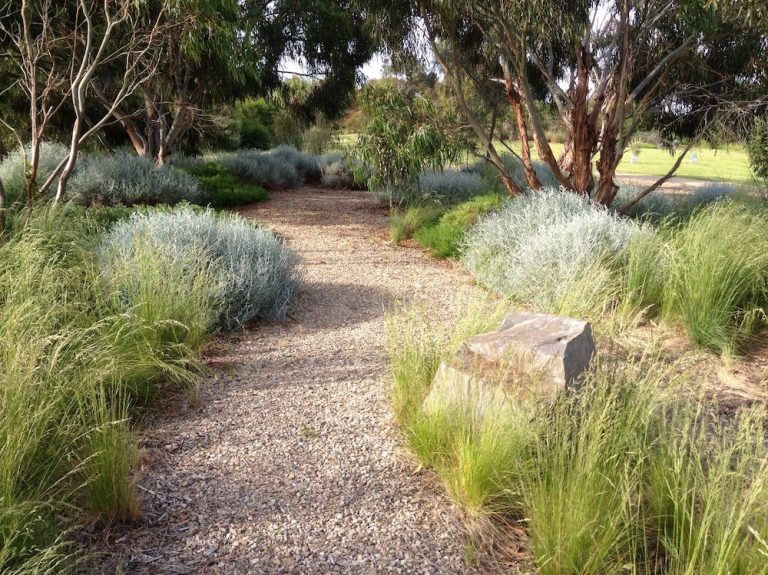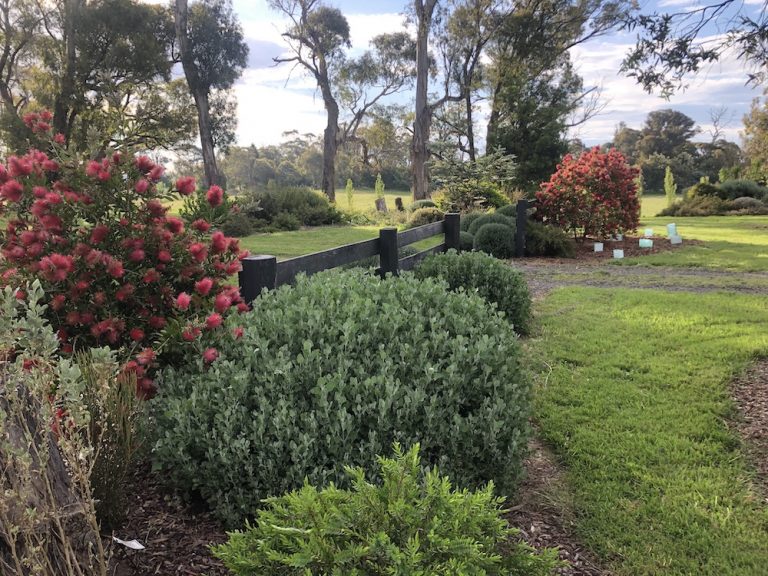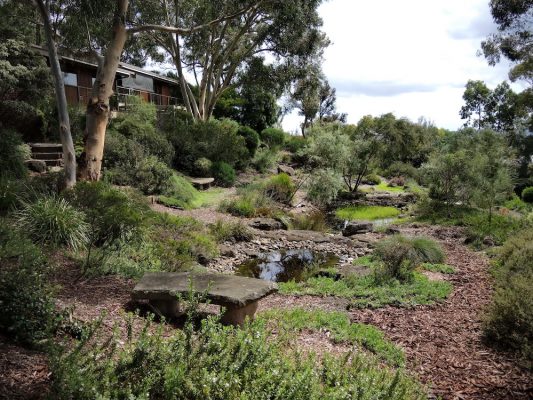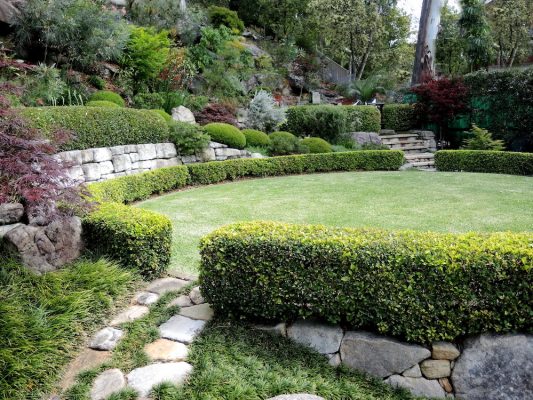This is a write up of the talk given at the ANPSA conference 2022
INTRODUCTION
Australian native plants are known to have many values of advantage to humans. I’ve delved through history to identify how native plants have been appreciated in the past, and if they may have informed the garden design of the present, and then ‘best guessed’ what might be expected of them in the future. Come along it is an intriguing story . . . .
Historic Precedents in Garden Design
Pre-Settlement:
Before European settlement, the original natural landscape of the continent was one bountiful, unique and diverse ‘native garden’, fundamentally important to the continuing survival of our First Nation’s people. They traversed the land cyclically, and sustainably, and harvested foods throughout the distinctive seasons and the varied regional areas. This knowledge was inherited and passed down through the generations as a matter of survival.
The aboriginal people did not ‘design’ gardens, they did not need to.
Indigenous Flora:
This traditional knowledge, understanding and stewardship of this unique natural environment, specifically the flora, was derived over thousands of years by the people of the First Nation’s, and should be revered and never be forgotten.
It is imperative that this related indigenous knowledge continues to be preserved, valued and applied to inform planning and design for the use of native plants in contemporary and in future landscapes and gardens.
In the 1700’s:
From the commencement of settlement in 1788, the local landscape and flora was not widely respected or appreciated. Establishing the new colony in this strange land where everything seemed to be ‘upside down’, took precedence.
Native plants were not seen to be of value or of much use for gardens, and instead were treated as something to be dismissed, dominated or replaced.
In the 1800’s:
During the nineteenth century the influence of Victorian England was strong, and apart from food production, gardening was not a main concern for the people of the developing colonial settlements.
Regardless of the many explorer/botanists who at the time progressively discovered and documented the unique, previously unknown flora across the continent, the early colonists did not value the local environment, and the native flora was not widely understood.

The Present Period of Garden Design – in the 1900’s
In the 1900’s:
From early in the twentieth century, Federation inspired designers in all states, to consider the country’s unique environment and incorporate the flora to inform the design of gardens that truly belonged here.
The early designers all had a heightened sense of being Australian, they lived in the Australian landscape, and each exhibited a passion for designing gardens with a ‘sense of local place’ rather than copying some unrelated ‘imported landscape’.
It is this national legacy that particularly inspired the typical informal ‘Australian Style’ walkabout or stroll gardens we know so well today.
Diversity of landscape:
The sheer size and diversity of our continent with its wealth of unique natural landscapes, from the Top End to Tasmania; and from Perth to sub-tropical Queensland, obviously makes the concept of one ‘Australian Style’ for gardens a nonsense.
This initial aspiration has largely evolved into a simple, more realistic and ecologically sustainable goal of creating gardens and landscapes with a ‘Sense of Local Place’.
The result is that today, throughout the continent we have a great diversity of garden characters which reflect a specific design brief, but are most forcefully informed by the particular site location, the local environment and the local climate – each component inspiring ‘Design WITH Nature’.
Environment values:
Today, more than ever, Australians need to be introduced to, and informed about sustainability, particularly highlighting the significant environmental benefits of gardening with native plants, and not just the aesthetic qualities of the plants alone.
One definition for the design of a sustainable garden suggests that: it thrives with minimal water and maintenance; exhibits steady growth with potential for regeneration; and uses indigenous flora that supports both itself, and the reliant creatures large and small.
Consequently, landscape projects of all scales that sustainably preserve the environments we value, and aim to prevent the loss of endangered species, are undoubtedly one of the most important investments in our future, and this is equally if not more relevant, for our personal gardens.
Climate Change:
From what we have been told, the climatic patterns are a changing matrix, some regions drier, others wetter. But is that really any different to now? As gardeners we carefully select and use native species that are appropriate to the local region, instead of wasting time and energy in ‘encouraging’ inappropriate specimens to grow where they really don’t want to be.
Since our members all ‘native plant nuts’, and irrespective of any imposed future changes, I feel sure we will still continue to establish our gardens as we always have . . . . because the changes are subtle, and happen over long periods, we will have time to modify our approach
Certainly, these impacts are already being experienced, but just as the Australian flora has adapted over millennia, tomorrow’s gardeners will also learn to progressively adapt their gardens to respond to any new global or local changes or processes that are imposed.

What about Garden Design in the Future?
Whatever happens in years to come, the basic principles of garden planning and design will remain largely unchanged – microclimate, visual attributes, character & style, plant form, colour and texture etc, even pruning to form, will still be applicable in any new or modified situations.
Consider also that most of the future population will live in smaller homes and in multi-storey apartments; their gardens will need smaller specimens and suitable container plants; in consequence nursery supply and garden design will need appropriate modification.
For reasons of sustainability, many new multi storey buildings in urban city centres are now often clad in curtains of green foliage, with verdant roof gardens. Difficult physical situations like these are not uncommon in the natural landscape, consequently ‘nature’ will be a continuing reference to inform design and plant selection for these ‘vertical and horizontal gardens’.
Consider also the growing influence of technology – breeding new cultivars, hybrids, grafting etc – producing new ‘designer plants’ that will grow where they were never meant to be. As a result, in the future, could our landscapes and gardens look the same everywhere across the continent? Will there still be a ‘sense of LOCAL place’ to distinguish one region from another? Is this a valid concern?
As a landscape architect, it is my considered opinion that these expected future imposed changes will require that tertiary training institutions in landscape and horticulture, immediately increase emphasis on the environmental significance and relevance in the use of native plants in landscape planning and in garden design – at least on an equal basis to that currently offered for exotic flora, but hopefully far greater!
In ‘Imagining the future’ I don’t really see too much change from the way we garden now, provided we continue to understand and apply the principles of Design with Nature. But for me, one thing is absolutely certain – against my better judgement, I will continue to try growing Eremophila species in my garden in entirely the wrong wet, humid, subtropical climatic zone, and no doubt in future this will still be without success!
The Future Influence of our Society:
Since the founding of our Society 65 years ago, our members have in so many ways, made it their business to constantly inform the community about the importance of preservation, conservation, and of using native plants in the landscape and in garden design.
No other group could, or ever has, contributed so freely to the wider community, with so much specialised environmental, botanical, horticultural, and personal knowledge – locally, nationally, and even internationally.
As a Society represented in every state, and particularly through the Study Groups, we must continue to do everything possible to inform, assist, and ground Australians in understanding the significance and use of their own landscape – this is an extremely important task.
Value that work! The awakening and encouraging of public appreciation about our native species are so vitally important, and will become even more important in the future as climate change impacts, and more particularly as our population expands while also becoming increasingly multi-cultural.
In Conclusion:
This presentation has not dealt with broad-scale landscape issues, because our ANPSA members have a specific interest ‘in our own patch’, we are doers, and our personal gardens matter very much to us.
I believe that we all deserve ‘a hearty pat on the back’ to acknowledge and encourage our interest, and particularly to ensure our continuing commitment to inform the general community about the value of native plants, as a vital and integral component in the design of the sustainable landscapes and gardens of our future.
Lawrence Smith AM Landscape Architect
ANPSA Garden Design Study Group Leader


